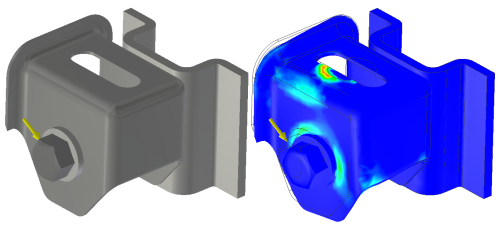A stress analysis can help you find the best design alternatives for a part or assembly. Early in design development, you can ensure that a design performs satisfactorily under expected use without breaking or deforming.

- Static Analysis evaluates structural loading conditions.
- Modal Analysis evaluates natural frequency modes, including rigid body movements.
- Creates the cases.
- Performs the geometric modeling.
- Performs automatic contact detection.
- Generate meshes.
- Solves the model for each data point.
After the simulation, you evaluate the results in the graphics region.

Assembly features and weldments are supported. Any parameter used for these features can be included in a Parametric Dimension simulation, weld beads included.
Weld bodies contribute to the body list, and are evaluated for contact and meshed. For welds where the face contacts are not welded, we recommend that you use the Separation contact type. Non-weld face contacts are not ideally bonded. To do so could require editing an automatic contact or manually adding a contact.
In addition to the Stress Analysis Settings dialog box, a Parametric Table, and Simulation Guide are available to assist you with your simulation process.
Typical process for Stress Analysis
- Set expectations Estimate physical behavior using a conceptual model.
- Preprocessing Define material and boundary conditions (loads and constraints), and specify contact conditions and any mesh preferences.
- Solving Run the simulation to solve your mathematical representation, and generate the solution. To find a result, the part is divided into smaller elements. The solver adds up the individual behaviors of each element. It predicts the behavior of the entire physical system by resolving a set of simultaneous algebraic equations.
- Post-processing Display and evaluate the results.
- Review expectations Post-processing is the study of the results of the solution, and the improve inputs phase of the process.
-
Conclusion (Improve Inputs) Do the results match the expectations?
If the answer is YES, your analysis work is concluded.
If the answer is NO, you modify any of the inputs to improve the results. To modify, you can reduce geometric complexity, remove questionable geometry, change the loads or constraints, change the analysis type, and so on. The refinement is a highly iterative process.